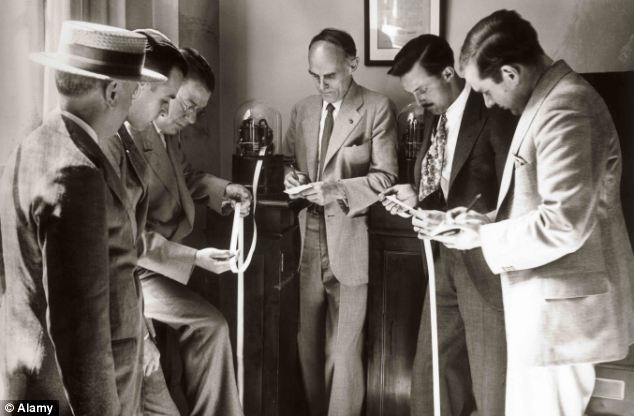Become A Modern Day Tape Reader

When one thinks of a tape reader, someone who read the ticker tape, they tend to think back to the 1920’s where everyone would stand around a machine with a glass top and a piece of paper, like a receipt, would come out with the recent stock trades on it. I always wondered how those traders used that information in making their trading decisions.
Times have certainly changed, thank goodness! With advances in technology in the last 20 years in the area of home computing, a trader can get 100x more information on their home pc than what trades 100 years ago got from the ticker tape which essential just gave the price, volume traded and whether the price was above or below the previous day’s close.
When the computer came along the ticker tape was essentially trashed. I remember working on the CME floor and watching the ticker tape go across on a digital led screen.
Watching the tape today comes in several forms.
There are those who watch time and sales, which in my opinion is kind of useless because the sheer volume of trades going through and their speed is simply mind numbing. More often than not nowadays traders just have a time and sales window open and keep an eye on it looking for big trades that are going through.
The next and more popular group are traders who use a DOM (depth of market) to trade. I do use a DOM for my own trading because I like to see where the bids and offers are sitting in the market. It is tricky to try and trade only from a DOM without and charts because unless you know what to look for and have excellent discipline you will find yourself taking more trades than you probably should because you will think you see things that look like good trades when in reality you are being punked. Even though spoofing has been outlawed, people are still doing it, but maybe just not on the same scale as in the past. Trading with only a DOM you are basically trading off the intentions of others. You are watching orders come in and get filled, cancelled, moved up and down, etc. While there are many that are successful trading in this way, I don’t find any value in concentrating on orders that are not going to get filled. I would rather spend my time analysing what has actually traded.
If you want to use a more advanced DOM for trading besides the one that comes with your charting program I recommend the one from Jigsaw Trading. It’s great, enough said.
That brings us to order flow trading. DOM traders will argue the semantics of the words Order Flow Trading saying they are the true order flow traders because they are making trades based off the flow of orders in the market. While trading order flow off of a volume ladder or foot print chart is trading in the past tense because those orders have already been filled. To me order flow is about filled orders, not spoofs, not limits, not orders stacked in the order book.
So what makes a volume ladder or foot print chart a better way to trade? Quite simply when orders are filled the trader then has a position in the market, skin in the game so to speak. When prices move they feel it. When orders are just sitting in the book, traders can move them, cancel them, do whatever they want. Real traders trade, they don’t try to game the market in general. They need to accumulate inventory or reduce inventory. That is the real reason markets exist.
When you look at an Orderflows Trader chart you can see at a glance where institutions are buying or selling, where there is aggressive participation, where there is a lack of participation and so much more.
I think DOM based traders are more of a spill over from the days of pit trading where locals would stand there and watch the orders come in from the brokers on the phones around the trading pit. But the big difference was the orders coming into the pit via hand signals were actually going to trade. The orders that were limits were run into the pit on paper and held in a broker’s deck and the traders in the pit were mostly unaware of those levels unless they had an in with the broker’s clerk.
Really there is no comparing DOM trading to order flow chart trading. It is two different types of trading. DOM trading will definitely get your blood flowing and your blood pressure high. That leads me to another problem I have with DOM trading – the trades are too short and as a result so are the profit targets. Most DOM traders are happy with a few ticks profit especially since they are risking 1 or 2 ticks. There in lies the rub, for traders who don’t have the discipline DOM trading can quickly blow out your account because they are more apt to let losing trades go a little further than they should. They think they will just give the market another tick to correct itself and in the end the other tick becomes more than just one or two. So in the end they went from risking one or two ticks to make 3 or 4 ticks, to risking 4 or 5 ticks to make 3 or 4 ticks. That is a sure recipe for disaster.
With order flow chart trading you are not living and dying with each tick that comes into the market. If you are trading range charts or even 5 minute charts you can watch how the trade develops as the market evolves.
When one thinks of the tape readers of old, you will remember that the tape, just gave price and volume traded. It didn’t tell them were orders were in the book. So I find that trading with an order flow chart is more conducive to my style of trading which is more longer term than a minute or two but less than an hour and going for points of profit as opposed to just ticks.
I created the Orderflows Trader software so that I could read the market more clearly than just using candlestick charts. Orderflows Trader allows me to see inside the candlestick and determine what forces are at play in the market at any given time.
Happy Trading.
Mike








